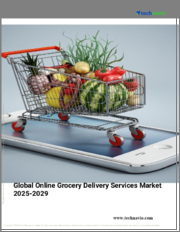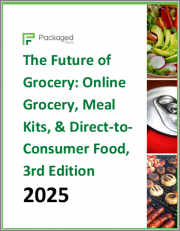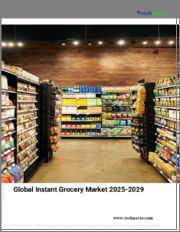
|
시장보고서
상품코드
1608122
세계의 인스턴트 식료품 시장 : 유형별, 제품별 예측(2025-2030년)Instant Grocery Market by Type (Food, Non Food), Product (Fresh Produce, Grocery & Staples, Household Items) - Global Forecast 2025-2030 |
||||||
인스턴트 식료품 시장 규모는 2023년에 2,093억 4,000만 달러로 평가되었으며, 2024년에는 2,454억 달러에 이를 것으로 예상됩니다. 또한, 2030년까지 연평균 성장률 13.80%로 성장하여 5,174억 5,000만 달러에 이를 것으로 전망됩니다.
인스턴트 식료품 시장에는 소비자가 식료품을 구입하고 보통 1시간 이내라는 매우 짧은 시간 프레임에서 받을 수 있는 서비스가 포함되어 있습니다. 신선 식품에 대한 빠른 액세스, 식료품 주식에 대한 소비자 수요 증가에 대응하고 있습니다.의 단축, 디지털 커머스의 침투 증가에 의해 초래되고 있습니다.이 서비스는 모바일 앱이나 웹 플랫폼을 활용해 주문 프로세스를 합리화해, 고급 물류 인프라를 활용해 신속한 배송을 실현 하는 경우가 많습니다.주된 최종 이용 부문은 도시의 일반 가정, 사회인, 시간 효율이 좋은 쇼핑 방법을 요구하는 하이테크에 정통한 소비자등입니다.
| 주요 시장 통계 | |
|---|---|
| 기준연도(2023) | 2,093억 4,000만 달러 |
| 추정연도(2024) | 2,454억 달러 |
| 예측연도(2030) | 5,174억 5,000만 달러 |
| 복합 연간 성장률(CAGR)(%) | 13.80% |
시장에 영향을 미치는 주요 성장 요인으로는 디지털 결제 기술의 진보, 스마트폰의 보급, 보다 신속한 서비스를 위한 배송 루트의 최적화에 있어서의 인공지능의 채용 등이 있습니다. 코로나19 팬데믹은 비대면 및 당일 배송 옵션에 대한 수요를 촉진하여 상당한 성장 기회를 제공했습니다. 업계 관계자들은 견고한 디지털 인프라에 투자하고, 공급망 관리를 위한 AI 기반 솔루션을 강화하며, 지역 식료품점 및 배송 서비스 제공업체와 전략적 파트너십을 구축함으로써 이러한 수요를 활용할 수 있습니다. 잠재적인 기회는 시장 침투율이 낮은 도시 지역 진출, 신선 농산물 및 유기농 농산물을 포함한 제품 범위 확대, 그리고 데이터 기반 접근 방식을 통한 고객 경험 개인화에 있습니다.
그럼에도 불구하고, 인스턴트 식료품 시장은 부패하기 쉬운 상품 관리에 따른 물류 문제, 높은 운영 비용, 그리고 기존 대형 유통업체와 신생 스타트업의 치열한 경쟁과 같은 한계에 직면해 있습니다. 또한, 일관된 제품 공급과 배송 기대치 관리는 상당한 어려움을 야기합니다. 혁신과 연구가 가장 필요한 분야는 지속 가능한 포장 솔루션 개발, 자율주행 배송 차량 개발, 그리고 드론 배송 역량 확대 등이 있습니다. 이러한 분야에 집중하면 효율성을 높이고 비용을 절감할 수 있습니다. 인스턴트 식료품 시장은 역동적이며, 빠른 기술 도입과 변화하는 소비자 행동이 특징입니다. 따라서 시장 참여자들은 성장과 경쟁력을 유지하기 위해 지속적인 적응과 전략적 계획을 수립해야 합니다.
시장 역학 : 빠르게 진화하는 인스턴트 식료품 시장의 주요 시장 인사이트 공개
인스턴트 식료품 시장은 수요 및 공급의 역동적인 상호 작용에 의해 변모를 이루고 있습니다. 그리고 새로운 비즈니스 기회를 얻기 위해 준비 될 수 있습니다. 이러한 동향을 종합적으로 파악함으로써 기업은 정치적, 지리적, 기술적, 사회적, 경제적인 영역에 걸친 다양한 리스크를 경감할 수 있음과 동시에 소비자 행동과 그것이 제조 비용과 구매 동향에 미치는 영향을 보다 명확하게 이해할 수 있습니다.
- 시장 성장 촉진요인
- 소비자의 라이프 스타일의 변화와 온라인 채널의 채용
- 노동 인구 증가
- 전자상거래의 현저한 보급
- 시장 성장 억제요인
- 인프라 비용에 대한 우려
- 시장 기회
- 온라인 구매시 프로모션 활동과 할인 가격
- 신속하고 하루에 배달하는 솔루션의 출현
- 시장의 과제
- 위조품의 유통과 품질 문제
Porter's Five Forces : 인스턴트 식료품 시장을 탐색하는 전략 도구
Porter's Five Forces(5 가지 힘)는 시장 상황경쟁 구도를 파악하는 중요한 도구입니다. Porter's Five Forces Framework는 기업의 경쟁력을 평가하고 전략적 기회를 탐구하는 명확한 기술을 제공합니다. 이 프레임워크는 기업이 시장 내 세력도를 평가하고 신규 사업의 수익성을 판단하는 데 도움이 됩니다. 이러한 인사이트을 통해 기업은 자사의 강점을 활용하고 약점을 해결하고 잠재적인 과제를 피함으로써 보다 강인한 시장에서의 포지셔닝을 확보할 수 있습니다.
PESTLE 분석 : 인스턴트 식료품 시장의 외부 영향을 파악
외부 거시 환경 요인은 인스턴트 식료품 시장의 성과 역학을 형성하는 데 매우 중요한 역할을합니다. 정치적, 경제적, 사회적, 기술적, 법적, 환경적 요인 분석은 이러한 영향을 탐색하는 데 필요한 정보를 제공합니다. PESTLE 요인을 조사함으로써 기업은 잠재적인 위험과 기회를 더 잘 이해할 수 있습니다. 이 분석을 통해 기업은 규제, 소비자 선호, 경제 동향의 변화를 예측하고 앞으로 예상되는 적극적인 의사 결정을 할 준비가 가능합니다.
시장 점유율 분석 인스턴트 식료품 시장 경쟁 구도 파악
인스턴트 식료품 시장의 상세한 시장 점유율 분석을 통해 공급업체의 성과를 종합적으로 평가할 수 있습니다. 기업은 수익, 고객 기반, 성장률 등 주요 지표를 비교하여 경쟁 포지셔닝을 밝힐 수 있습니다. 이 분석을 통해 시장 집중, 단편화, 통합 동향을 밝혀내고 벤더들은 경쟁이 치열해지는 가운데 자사의 지위를 높이는 전략적 의사 결정을 내리는 데 필요한 지식을 얻을 수 있습니다.
FPNV 포지셔닝 매트릭스 인스턴트 식료품 시장에서 공급업체의 성능 평가
FPNV 포지셔닝 매트릭스는 인스턴트 식료품 시장에서 벤더를 평가하는 중요한 도구입니다. 이 행렬을 통해 비즈니스 조직은 공급업체의 비즈니스 전략과 제품 만족도를 기준으로 평가하여 목표에 맞는 충분한 정보를 바탕으로 의사 결정을 내릴 수 있습니다. 네 가지 사분면을 통해 공급업체를 명확하고 정확하게 세분화하여 전략 목표에 가장 적합한 파트너 및 솔루션을 파악할 수 있습니다.
전략 분석 및 추천 인스턴트 식료품 시장의 성공에 대한 길을 그립니다.
인스턴트 식료품 시장의 전략 분석은 시장에서의 프레즌스 강화를 목표로 하는 기업에 필수적인 요소입니다. 이러한 접근 방식을 통해 경쟁 구도에서 과제를 극복하고 새로운 비즈니스 기회를 활용하여 장기적인 성공을 거둘 수 있는 체제를 구축할 수 있습니다.
이 보고서는 주요 관심 분야를 포괄하는 시장의 종합적인 분석을 제공합니다.
1. 시장 침투 : 현재 시장 환경의 상세한 검토, 주요 기업의 광범위한 데이터, 시장 도달범위 및 전반적인 영향력 평가.
2. 시장 개척도 : 신흥 시장의 성장 기회를 파악하고 기존 분야의 확장 가능성을 평가하며 미래 성장을 위한 전략적 로드맵을 제공합니다.
3. 시장 다양화 : 최근 제품 출시, 미개척 지역, 업계의 주요 진보, 시장을 형성하는 전략적 투자를 분석합니다.
4. 경쟁 평가 및 정보 : 경쟁 구도를 철저히 분석하여 시장 점유율, 사업 전략, 제품 포트폴리오, 인증, 규제 당국 승인, 특허 동향, 주요 기업의 기술 진보 등을 검증합니다.
5. 제품 개발 및 혁신 : 미래 시장 성장을 가속할 것으로 예상되는 최첨단 기술, R&D 활동, 제품 혁신을 강조합니다.
또한 이해관계자가 충분한 정보를 얻고 의사결정을 할 수 있도록 중요한 질문에 대답하고 있습니다.
1. 현재 시장 규모와 향후 성장 예측은?
2. 최고의 투자 기회를 제공하는 제품, 부문 및 지역은 어디입니까?
3. 시장을 형성하는 주요 기술 동향과 규제의 영향은?
4. 주요 벤더의 시장 점유율과 경쟁 포지션은?
5. 벤더 시장 진입, 철수 전략의 원동력이 되는 수익원과 전략적 기회는 무엇인가?
목차
제1장 서문
제2장 조사 방법
제3장 주요 요약
제4장 시장 개요
제5장 시장 인사이트
- 시장 역학
- 성장 촉진요인
- 소비자의 라이프 스타일의 변화와 온라인 채널의 채용
- 노동 인구 증가
- 전자상거래 부문의 대폭적인 증가
- 억제요인
- 인프라 비용에 대한 우려
- 기회
- 프로모션 활동과 온라인 구매시 할인 가격
- 새로운 신속, 당일 배송 솔루션
- 과제
- 위조품의 유통과 품질의 문제
- 성장 촉진요인
- 시장 세분화 분석
- Porter's Five Forces 분석
- PESTEL 분석
- 정치적
- 경제
- 사교
- 기술적
- 법률상
- 환경
제6장 인스턴트 식료품 시장 : 유형별
- 음식
- 식품 이외
제7장 인스턴트 식료품 시장 : 제품별
- 신선한 농산물
- 식료품 및 일용품
- 가정용품
- 포장 식품
- 퍼스널케어
제8장 아메리카의 인스턴트 식료품 시장
- 아르헨티나
- 브라질
- 캐나다
- 멕시코
- 미국
제9장 아시아태평양의 인스턴트 식료품 시장
- 호주
- 중국
- 인도
- 인도네시아
- 일본
- 말레이시아
- 필리핀
- 싱가포르
- 한국
- 대만
- 태국
- 베트남
제10장 유럽, 중동 및 아프리카의 인스턴트 식료품 시장
- 덴마크
- 이집트
- 핀란드
- 프랑스
- 독일
- 이스라엘
- 이탈리아
- 네덜란드
- 나이지리아
- 노르웨이
- 폴란드
- 카타르
- 러시아
- 사우디아라비아
- 남아프리카
- 스페인
- 스웨덴
- 스위스
- 터키
- 아랍에미리트(UAE)
- 영국
제11장 경쟁 구도
- 시장 점유율 분석(2023년)
- FPNV 포지셔닝 매트릭스(2023년)
- 경쟁 시나리오 분석
- 전략 분석과 제안
기업 목록
- Albertsons Co. Inc.
- Alphabet Inc.
- Amazon.com, Inc.
- Blue Apron Holdings Inc.
- Buymie Technologies Ltd.
- Delivery Hero SE
- DoorDash, Inc.
- HelloFresh SE
- Instacart
- Koninklijke Ahold Delhaize NV
- Kroger Co.
- Maplebear Inc.
- Ocado Retail Ltd.
- Reliance Industries Ltd.
- Swiggy
- Target Corporation
- Tata Sons Pvt. Ltd.
- Uber Technologies, Inc.
- Walmart, Inc.
- We Deliver Local Ltd.
The Instant Grocery Market was valued at USD 209.34 billion in 2023, expected to reach USD 245.40 billion in 2024, and is projected to grow at a CAGR of 13.80%, to USD 517.45 billion by 2030.
The instant grocery market encompasses services that allow consumers to purchase groceries and receive them within a very short time frame, typically under an hour. This market addresses the growing consumer demand for convenience, quick access to fresh produce, and pantry staples amid their busy lifestyles. The necessity of instant grocery services is driven by the trend toward urbanization, reduced time for traditional shopping, and the increasing penetration of digital commerce. Applications of these services often leverage mobile apps and web platforms to streamline ordering processes and utilize advanced logistics infrastructures for rapid delivery. The primary end-use sectors include urban households, working professionals, and tech-savvy consumers seeking time-efficient shopping methods.
| KEY MARKET STATISTICS | |
|---|---|
| Base Year [2023] | USD 209.34 billion |
| Estimated Year [2024] | USD 245.40 billion |
| Forecast Year [2030] | USD 517.45 billion |
| CAGR (%) | 13.80% |
Key growth factors influencing the market include advancements in digital payment technologies, the proliferation of smartphone usage, and the adoption of artificial intelligence in optimizing delivery routes for faster service. The COVID-19 pandemic catalyzed the demand for contactless and same-day delivery options, presenting significant growth opportunities. Industry players can capitalize on this demand by investing in robust digital infrastructures, enhancing AI-driven solutions for supply chain management, and forming strategic partnerships with local grocery stores and delivery service providers. Potential opportunities lie in tapping into underpenetrated urban areas, expanding product range to include fresh and organic produce, and personalizing customer experiences through data-driven approaches.
Nevertheless, the market faces limitations such as logistical challenges in managing perishable goods, high operational costs, and intense competition from established retail giants and emerging start-ups. Additionally, ensuring consistent product availability and managing delivery expectations pose significant hurdles. The best areas for innovation and research include developing sustainable packaging solutions, exploring autonomous delivery vehicles, and expanding capabilities for drone deliveries. Focusing on these areas can enhance efficiency and reduce costs. The instant grocery market is dynamic, characterized by rapid technological adoption and changing consumer behaviors, necessitating continuous adaptation and strategic planning by market players to sustain growth and competitiveness.
Market Dynamics: Unveiling Key Market Insights in the Rapidly Evolving Instant Grocery Market
The Instant Grocery Market is undergoing transformative changes driven by a dynamic interplay of supply and demand factors. Understanding these evolving market dynamics prepares business organizations to make informed investment decisions, refine strategic decisions, and seize new opportunities. By gaining a comprehensive view of these trends, business organizations can mitigate various risks across political, geographic, technical, social, and economic domains while also gaining a clearer understanding of consumer behavior and its impact on manufacturing costs and purchasing trends.
- Market Drivers
- Changing consumer lifestyles and adoption of online channels
- Rising number of working populations
- Significant proliferation of e-commerce sector
- Market Restraints
- Concern regarding infrastructure cost
- Market Opportunities
- Promotional activities and discounted price on online purchase
- Emerging rapid and one-day delivery solutions
- Market Challenges
- Availability of counterfeit products and quality issues
Porter's Five Forces: A Strategic Tool for Navigating the Instant Grocery Market
Porter's five forces framework is a critical tool for understanding the competitive landscape of the Instant Grocery Market. It offers business organizations with a clear methodology for evaluating their competitive positioning and exploring strategic opportunities. This framework helps businesses assess the power dynamics within the market and determine the profitability of new ventures. With these insights, business organizations can leverage their strengths, address weaknesses, and avoid potential challenges, ensuring a more resilient market positioning.
PESTLE Analysis: Navigating External Influences in the Instant Grocery Market
External macro-environmental factors play a pivotal role in shaping the performance dynamics of the Instant Grocery Market. Political, Economic, Social, Technological, Legal, and Environmental factors analysis provides the necessary information to navigate these influences. By examining PESTLE factors, businesses can better understand potential risks and opportunities. This analysis enables business organizations to anticipate changes in regulations, consumer preferences, and economic trends, ensuring they are prepared to make proactive, forward-thinking decisions.
Market Share Analysis: Understanding the Competitive Landscape in the Instant Grocery Market
A detailed market share analysis in the Instant Grocery Market provides a comprehensive assessment of vendors' performance. Companies can identify their competitive positioning by comparing key metrics, including revenue, customer base, and growth rates. This analysis highlights market concentration, fragmentation, and trends in consolidation, offering vendors the insights required to make strategic decisions that enhance their position in an increasingly competitive landscape.
FPNV Positioning Matrix: Evaluating Vendors' Performance in the Instant Grocery Market
The Forefront, Pathfinder, Niche, Vital (FPNV) Positioning Matrix is a critical tool for evaluating vendors within the Instant Grocery Market. This matrix enables business organizations to make well-informed decisions that align with their goals by assessing vendors based on their business strategy and product satisfaction. The four quadrants provide a clear and precise segmentation of vendors, helping users identify the right partners and solutions that best fit their strategic objectives.
Strategy Analysis & Recommendation: Charting a Path to Success in the Instant Grocery Market
A strategic analysis of the Instant Grocery Market is essential for businesses looking to strengthen their global market presence. By reviewing key resources, capabilities, and performance indicators, business organizations can identify growth opportunities and work toward improvement. This approach helps businesses navigate challenges in the competitive landscape and ensures they are well-positioned to capitalize on newer opportunities and drive long-term success.
Key Company Profiles
The report delves into recent significant developments in the Instant Grocery Market, highlighting leading vendors and their innovative profiles. These include Albertsons Co. Inc., Alphabet Inc., Amazon.com, Inc., Blue Apron Holdings Inc., Buymie Technologies Ltd., Delivery Hero SE, DoorDash, Inc., HelloFresh SE, Instacart, Koninklijke Ahold Delhaize NV, Kroger Co., Maplebear Inc., Ocado Retail Ltd., Reliance Industries Ltd., Swiggy, Target Corporation, Tata Sons Pvt. Ltd., Uber Technologies, Inc., Walmart, Inc., and We Deliver Local Ltd..
Market Segmentation & Coverage
This research report categorizes the Instant Grocery Market to forecast the revenues and analyze trends in each of the following sub-markets:
- Based on Type, market is studied across Food and Non Food.
- Based on Product, market is studied across Fresh Produce, Grocery & Staples, Household Items, Packaged Food, and Personal Care.
- Based on Region, market is studied across Americas, Asia-Pacific, and Europe, Middle East & Africa. The Americas is further studied across Argentina, Brazil, Canada, Mexico, and United States. The United States is further studied across California, Florida, Illinois, New York, Ohio, Pennsylvania, and Texas. The Asia-Pacific is further studied across Australia, China, India, Indonesia, Japan, Malaysia, Philippines, Singapore, South Korea, Taiwan, Thailand, and Vietnam. The Europe, Middle East & Africa is further studied across Denmark, Egypt, Finland, France, Germany, Israel, Italy, Netherlands, Nigeria, Norway, Poland, Qatar, Russia, Saudi Arabia, South Africa, Spain, Sweden, Switzerland, Turkey, United Arab Emirates, and United Kingdom.
The report offers a comprehensive analysis of the market, covering key focus areas:
1. Market Penetration: A detailed review of the current market environment, including extensive data from top industry players, evaluating their market reach and overall influence.
2. Market Development: Identifies growth opportunities in emerging markets and assesses expansion potential in established sectors, providing a strategic roadmap for future growth.
3. Market Diversification: Analyzes recent product launches, untapped geographic regions, major industry advancements, and strategic investments reshaping the market.
4. Competitive Assessment & Intelligence: Provides a thorough analysis of the competitive landscape, examining market share, business strategies, product portfolios, certifications, regulatory approvals, patent trends, and technological advancements of key players.
5. Product Development & Innovation: Highlights cutting-edge technologies, R&D activities, and product innovations expected to drive future market growth.
The report also answers critical questions to aid stakeholders in making informed decisions:
1. What is the current market size, and what is the forecasted growth?
2. Which products, segments, and regions offer the best investment opportunities?
3. What are the key technology trends and regulatory influences shaping the market?
4. How do leading vendors rank in terms of market share and competitive positioning?
5. What revenue sources and strategic opportunities drive vendors' market entry or exit strategies?
Table of Contents
1. Preface
- 1.1. Objectives of the Study
- 1.2. Market Segmentation & Coverage
- 1.3. Years Considered for the Study
- 1.4. Currency & Pricing
- 1.5. Language
- 1.6. Stakeholders
2. Research Methodology
- 2.1. Define: Research Objective
- 2.2. Determine: Research Design
- 2.3. Prepare: Research Instrument
- 2.4. Collect: Data Source
- 2.5. Analyze: Data Interpretation
- 2.6. Formulate: Data Verification
- 2.7. Publish: Research Report
- 2.8. Repeat: Report Update
3. Executive Summary
4. Market Overview
5. Market Insights
- 5.1. Market Dynamics
- 5.1.1. Drivers
- 5.1.1.1. Changing consumer lifestyles and adoption of online channels
- 5.1.1.2. Rising number of working populations
- 5.1.1.3. Significant proliferation of e-commerce sector
- 5.1.2. Restraints
- 5.1.2.1. Concern regarding infrastructure cost
- 5.1.3. Opportunities
- 5.1.3.1. Promotional activities and discounted price on online purchase
- 5.1.3.2. Emerging rapid and one-day delivery solutions
- 5.1.4. Challenges
- 5.1.4.1. Availability of counterfeit products and quality issues
- 5.1.1. Drivers
- 5.2. Market Segmentation Analysis
- 5.3. Porter's Five Forces Analysis
- 5.3.1. Threat of New Entrants
- 5.3.2. Threat of Substitutes
- 5.3.3. Bargaining Power of Customers
- 5.3.4. Bargaining Power of Suppliers
- 5.3.5. Industry Rivalry
- 5.4. PESTLE Analysis
- 5.4.1. Political
- 5.4.2. Economic
- 5.4.3. Social
- 5.4.4. Technological
- 5.4.5. Legal
- 5.4.6. Environmental
6. Instant Grocery Market, by Type
- 6.1. Introduction
- 6.2. Food
- 6.3. Non Food
7. Instant Grocery Market, by Product
- 7.1. Introduction
- 7.2. Fresh Produce
- 7.3. Grocery & Staples
- 7.4. Household Items
- 7.5. Packaged Food
- 7.6. Personal Care
8. Americas Instant Grocery Market
- 8.1. Introduction
- 8.2. Argentina
- 8.3. Brazil
- 8.4. Canada
- 8.5. Mexico
- 8.6. United States
9. Asia-Pacific Instant Grocery Market
- 9.1. Introduction
- 9.2. Australia
- 9.3. China
- 9.4. India
- 9.5. Indonesia
- 9.6. Japan
- 9.7. Malaysia
- 9.8. Philippines
- 9.9. Singapore
- 9.10. South Korea
- 9.11. Taiwan
- 9.12. Thailand
- 9.13. Vietnam
10. Europe, Middle East & Africa Instant Grocery Market
- 10.1. Introduction
- 10.2. Denmark
- 10.3. Egypt
- 10.4. Finland
- 10.5. France
- 10.6. Germany
- 10.7. Israel
- 10.8. Italy
- 10.9. Netherlands
- 10.10. Nigeria
- 10.11. Norway
- 10.12. Poland
- 10.13. Qatar
- 10.14. Russia
- 10.15. Saudi Arabia
- 10.16. South Africa
- 10.17. Spain
- 10.18. Sweden
- 10.19. Switzerland
- 10.20. Turkey
- 10.21. United Arab Emirates
- 10.22. United Kingdom
11. Competitive Landscape
- 11.1. Market Share Analysis, 2023
- 11.2. FPNV Positioning Matrix, 2023
- 11.3. Competitive Scenario Analysis
- 11.4. Strategy Analysis & Recommendation
Companies Mentioned
- 1. Albertsons Co. Inc.
- 2. Alphabet Inc.
- 3. Amazon.com, Inc.
- 4. Blue Apron Holdings Inc.
- 5. Buymie Technologies Ltd.
- 6. Delivery Hero SE
- 7. DoorDash, Inc.
- 8. HelloFresh SE
- 9. Instacart
- 10. Koninklijke Ahold Delhaize NV
- 11. Kroger Co.
- 12. Maplebear Inc.
- 13. Ocado Retail Ltd.
- 14. Reliance Industries Ltd.
- 15. Swiggy
- 16. Target Corporation
- 17. Tata Sons Pvt. Ltd.
- 18. Uber Technologies, Inc.
- 19. Walmart, Inc.
- 20. We Deliver Local Ltd.



















